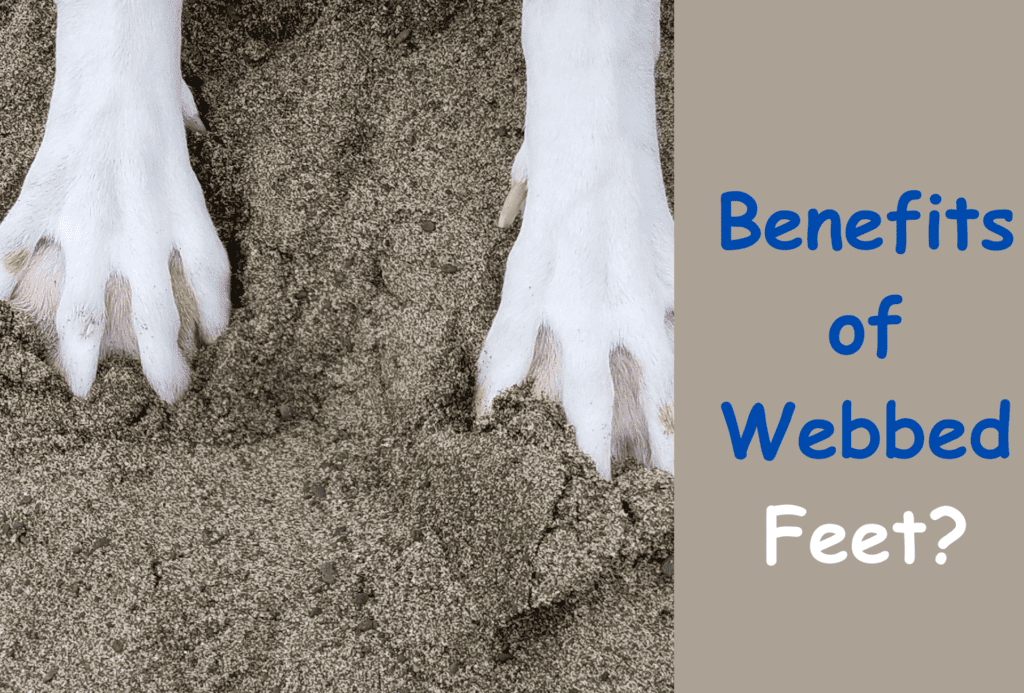Have you ever noticed that some dogs have webbed feet, while others do not? Webbed feet are a common feature in many aquatic animals, such as ducks, frogs, and otters. But what about dogs? Do all dogs have webbed feet?
Why do some dogs have webbed feet, and what does it mean for their health and performance? In this article, we will explore the topic of webbed feet in dogs, and answer some of the most frequently asked questions about this fascinating aspect of canine anatomy.
Contents
- 1 Why Does My Dog Have Webbed Feet? Do all dogs have webbed feet?
- 2 What is a powerful breed of dog with webbed feet?
- 3 Which dogs have no webbed feet?
- 4 Is a dog with webbed feet better than a regular one?
- 5 What are the benefits of webbed feet?
- 6 Is it normal for puppies to have webbed feet?
- 7 Dogs with webbed feet for swimming
- 8 Does a Pitbull have webbed feet?
- 9 How can I tell if my dog has webbed feet?
- 10 How to care for a dog with webbed feet?
- 11 Conclusion
- 12 FAQs: Do all dogs have webbed feet?
Why Does My Dog Have Webbed Feet? Do all dogs have webbed feet?
Webbed feet are a result of a genetic trait that causes the skin between the toes to be more connected than usual. This trait is also known as interdigital webbing or syndactyly. Webbed feet serve a biological purpose for certain dog breeds, as they help them perform better in specific activities or environments.
Some of the factors that influence the presence of webbed feet in dogs are:
- Breed origin: Some dog breeds were originally bred for tasks that involved water, such as hunting, retrieving, or fishing. These breeds developed webbed feet to help them swim faster and more efficiently. Some examples of water-loving breeds with webbed feet are Labradors, Newfoundlands, Portuguese Water Dogs, and Chesapeake Bay Retrievers.
- Adaptation: Some dog breeds developed webbed feet as a result of adapting to their natural habitats, such as snowy or marshy areas. Webbed feet help these breeds to walk on soft or slippery surfaces without sinking or sliding. Some examples of breeds adapted to harsh environments with webbed feet are Alaskan Malamutes, Siberian Huskies, and Great Pyrenees.
What is a powerful breed of dog with webbed feet?
Webbed feet can also be a sign of strength and power in some dog breeds. Webbed feet help these breeds to run faster, jump higher, and grip better. Some of the powerful breeds that are known for their webbed feet are:
German Shepherds:
These versatile and intelligent dogs are often used for police, military, or rescue work. Their webbed feet help them to sprint and chase, as well as to navigate different terrains and obstacles.
Rottweilers:
These loyal and protective dogs are often used for guarding, herding, or working. Their webbed feet help them to balance and maneuver, as well as to withstand heavy loads and pressure.
Doberman Pinschers:
These elegant and agile dogs are often used for personal protection, sports, or companionship. Their webbed feet help them to accelerate and decelerate, as well as to turn and pivot.
Suggested: Cocker Spaniel Growling And Snapping
When Do Rough Collies Stop Growing?
Which dogs have no webbed feet?
do all dog breeds have webbed feet? Not all dogs have webbed feet, and some breeds have very little or no webbing at all. This does not mean that these breeds are inferior or less capable than those with webbed feet.
It simply means that they have different physical characteristics and abilities that suit their purposes and preferences.
Some of the factors that influence the absence of webbed feet in dogs are:
- Breed history: Some dog breeds were not originally bred for tasks that involved water or challenging environments. These breeds did not need webbed feet to perform their roles and therefore did not develop them over time. Some examples of breeds that have little or no history of water or terrain work are Poodles, Dachshunds, and Chihuahuas.
- Breed standard: Some dog breeds have strict standards that define their appearance and features. These standards may exclude webbed feet as a desirable or acceptable trait for the breed. Some examples of breeds that have standards that discourage webbed feet are Boxers, Bulldogs, and Pugs.
Is a dog with webbed feet better than a regular one?
There is no definitive answer to whether a dog with webbed feet is better than a dog without webbed feet. Webbed feet are neither a flaw nor a virtue in dogs. They are simply variations that may or may not affect a dog’s performance or health.
Some of the advantages and disadvantages of webbed feet in dogs are:
Advantages:
Webbed feet can help a dog to swim faster, walk on soft or slippery surfaces, run faster, jump higher, and grip better. Webbed feet can also prevent dirt, debris, or parasites from getting stuck between the toes, and reduce the risk of injuries or infections.
Disadvantages:
Webbed feet can also cause some problems for a dog, such as difficulty trimming nails, increased sensitivity to cold or heat, or increased susceptibility to fungal or bacterial infections. Webbed feet can also interfere with a dog’s balance or coordination, or cause discomfort or pain.
Ultimately, whether webbed feet are beneficial or detrimental for a dog depends on several factors, such as the breed, the activity, the environment, and the individual dog. Webbed feet are not a guarantee of success or failure for a dog. They are simply one of the many aspects that make each dog unique and special.
What are the benefits of webbed feet?
Webbed feet can provide some benefits for dogs that engage in specific activities or environments that require or favor this trait. Some of the benefits of webbed feet are:
Swimming:
Webbed feet can help a dog swim faster and more efficiently, as they act like paddles that propel the dog through the water. Webbed feet can also help a dog to stay afloat and conserve energy, as they create more surface area and buoyancy. Webbed feet can be especially useful for dogs that swim for fun, sport, or work, such as retrieving, dock diving, or water rescue.
Walking:
Webbed feet can help a dog walk on soft or slippery surfaces, such as snow, mud, or sand. Webbed feet can prevent the dog from sinking or sliding, as they distribute the weight and pressure more evenly. Webbed feet can also help a dog to grip and stabilize, as they create more friction and traction. Webbed feet can be especially useful for dogs that walk on challenging terrains, such as hiking, sledding, or mushing.
Running:
Webbed feet can help a dog to run faster and more powerfully, as they increase the thrust and force of each stride. Webbed feet can also help a dog to accelerate and decelerate, as they enhance the control and agility of each movement. Webbed feet can be especially useful for dogs that run for sport, competition, or work, such as racing, agility, or herding.
Is it normal for puppies to have webbed feet?
Webbed feet are a normal and natural feature in some puppies, depending on their breed and genetics. Webbed feet usually develop during the embryonic stage, when the toes are still fused. As the puppy grows, the toes may separate more or less, resulting in different degrees of webbing.
Some of the factors that affect the development of webbed feet in puppies are:
- Breed: Some breeds are more likely to have webbed feet than others, due to their genetic makeup and ancestry. Some breeds may have webbed feet as a dominant or recessive trait, meaning that they may or may not pass it on to their offspring. Some breeds may also have webbed feet as a result of crossbreeding or mutation, meaning that they may have inherited it from another breed or developed it spontaneously.
- Individual: Some puppies may have more or less webbed feet than others, even within the same litter or breed. This is because webbed feet are influenced by several genes, and each puppy may have a different combination of alleles that determine the extent of webbing. Some puppies may also have webbed feet that vary in shape, size, or position, depending on how the skin and bones grow and align.
Webbed feet are usually noticeable in puppies from birth, but they may become more or less apparent as the puppy matures. Webbed feet are not a sign of any health or developmental issues in puppies unless they are accompanied by other symptoms or abnormalities, such as deformity, pain, infection, or lameness. Webbed feet are simply a part of a puppy’s anatomy, and they do not affect their personality or behavior.

Dogs with webbed feet for swimming
One of the most common and obvious reasons why some dogs have webbed feet is for swimming. Webbed feet are a great advantage for dogs that love or need to swim, as they help them move through the water with ease and efficiency. Webbed feet are not essential for swimming, as any dog can learn to swim with proper training and supervision, but they can certainly make swimming more enjoyable and rewarding for some dogs.
Some of the dog breeds that are specifically adapted for swimming due to their webbed feet are:
- Labradors: These friendly and energetic dogs are one of the most popular breeds for swimming, as they have a natural affinity and aptitude for water. Their webbed feet help them to swim fast and steady, as well as to retrieve objects from the water. Labradors are often used for hunting, fishing, or water sports, such as dock diving or flyball.
- Newfoundlands: These gentle and loyal dogs are one of the most impressive breeds for swimming, as they have remarkable strength and endurance in water. Their webbed feet help them to swim long and hard, as well as to rescue people or animals from drowning. Newfoundlands are often used for water rescue, therapy, or companionship.
- Portuguese Water Dogs: These lively and intelligent dogs are one of the most ancient breeds for swimming, as they have a rich history of working with fishermen and sailors. Their webbed feet help them to swim agile and nimble, as well as to herd fish or retrieve nets. Portuguese Water Dogs are often used for fishing, boating, or water games, such as water polo or surfing.
Does a Pitbull have webbed feet?
Pitbulls are a type of dog that is often misunderstood and misrepresented by the media and the public. Pitbulls are not a specific breed, but rather a term that encompasses several breeds that share similar characteristics, such as a muscular build, a short coat, and a strong jaw.
Pitbulls are often used for fighting, guarding, or working, but they can also be loving, loyal, and playful companions. One of the questions that many people have about Pitbulls is whether they have webbed feet. The answer is not so simple, as it depends on the individual dog and its genetic makeup. Some Pitbulls may have webbed feet, while others may not.
Some Pitbulls may have more or less webbing than others, depending on the degree of separation between their toes. Some Pitbulls may have visible webbed feet, while others may have hidden webbed feet.
Webbed feet are not a common or distinctive feature of Pitbulls, as they are of other breeds, such as Labradors, Newfoundlands, or Portuguese Water Dogs. Webbed feet are not a sign of a purebred or a mixed-breed Pitbull, as they can occur in both cases. Webbed feet are not a sign of a good or a bad Pitbull, as they do not affect their personality or behavior.
are all dog’s feet webbed? Webbed feet are simply a variation that may or may not be present in some Pitbulls, depending on their ancestry and genetics. Webbed feet may or may not provide some advantages or disadvantages for Pitbulls, depending on their activity and environment. Webbed feet are just one of the many aspects that make each Pitbull unique and special.
How can I tell if my dog has webbed feet?
Do all dogs have webbed feet? A simple way to tell if your dog has webbed feet is to pick up your dog’s paw and spread out his toes. If he has excessive skin between his toes, similar to a duck’s foot, then he has a webbed paw. But, unlike duck feet, dogs with webbed feet usually only have partial webbing, with the extra skin connecting the toes.
Webbed feet are a common feature in many dog breeds, especially those that were bred for water-related tasks, such as swimming, retrieving, or fishing. Webbed feet help these dogs to move faster and more efficiently in the water, as well as to walk on soft or slippery surfaces, such as snow, mud, or sand.
Some examples of dog breeds with webbed feet are Labradors, Newfoundlands, German Shepherds, Rottweilers, and Doberman Pinschers. However, not all dogs with webbed feet are good swimmers, and not all good swimmers have webbed feet. Webbed feet are just one of the many factors that affect a dog’s performance and health.
If you are curious about your dog’s breed and ancestry, you can try a DNA test kit that can reveal your dog’s genetic makeup and history. This can help you understand your dog’s physical and behavioral traits better, as well as any potential health risks or issues. You can find some of the best dog DNA test kits.
How to care for a dog with webbed feet?
Answer: A dog with webbed feet does not require any special care or treatment, as webbed feet are not a health or developmental issue. However, there are some things that owners of dogs with webbed feet can do to keep their paws healthy and comfortable. Some of these are:
Trimming nails:
Webbed feet can make it harder for dogs to trim their nails naturally, as they may not wear them down as much as other dogs. Therefore, owners of dogs with webbed feet should check and trim their nails regularly, to prevent them from growing too long or curling into the skin. This can cause pain, infection, or injury to the dog.
Cleaning and drying:
Webbed feet can trap dirt, debris, or moisture between the toes, which can lead to fungal or bacterial infections, such as yeast or interdigital cysts. Therefore, owners of dogs with webbed feet should clean and dry their paws thoroughly after swimming, walking, or playing, especially in wet or muddy areas. This can prevent the growth of harmful microorganisms and keep the skin healthy.
Protecting and moisturizing:
Webbed feet can be more sensitive to cold or heat, as they have more exposed skin and less fur. Therefore, owners of dogs with webbed feet should protect and moisturize their paws, especially in extreme weather conditions. This can prevent cracking, bleeding, or frostbite of the skin. Owners can use paw balms, boots, or socks to shield and nourish their dog’s paws.

Conclusion
Webbed feet are a fascinating and diverse feature in dogs, that can provide some benefits or challenges for certain breeds and activities. Webbed feet result from a genetic trait that influences the degree of skin connection between the toes, and they serve a biological purpose for some dogs that were bred or adapted for water or terrain work.
Do all dogs have webbed feet? Webbed feet are not a sign of superiority or inferiority in dogs, as they do not affect their personality or behavior. Webbed feet are simply a variation that may or may not be present in some dogs, depending on their ancestry and genetics.
Understanding this aspect of canine anatomy can help us to appreciate the diversity and uniqueness of each dog, and to provide them with the best care and environment for their needs and preferences.
FAQs: Do all dogs have webbed feet?
FAQ 1: Do all dogs have webbed feet?
Answer: No, not all dogs have webbed feet. Webbed feet are a result of a genetic trait that causes the skin between the toes to be more connected than usual. This trait is also known as interdigital webbing or syndactyly. Webbed feet serve a biological purpose for certain dog breeds, as they help them perform better in specific activities or environments. However, most dog breeds lose the majority of their webbing early in life and only retain a small amount of it that is barely noticeable.
FAQ 2: Which dog breeds have webbed feet?
Answer: Several dog breeds have webbed feet, either partially or fully. Some of the most common breeds with webbed feet are:
- Labradors: These friendly and energetic dogs are one of the most popular breeds for swimming, as they have a natural affinity and aptitude for water. Their webbed feet help them to swim fast and steady, as well as to retrieve objects from the water. Labradors are often used for hunting, fishing, or water sports, such as dock diving or flyball.
- Newfoundlands: These gentle and loyal dogs are one of the most impressive breeds for swimming, as they have remarkable strength and endurance in water. Their webbed feet help them to swim long and hard, as well as to rescue people or animals from drowning. Newfoundlands are often used for water rescue, therapy, or companionship.
- German Shepherds: These versatile and intelligent dogs are often used for police, military, or rescue work. Their webbed feet help them to sprint and chase, as well as to navigate different terrains and obstacles.
- Rottweilers: These loyal and protective dogs are often used for guarding, herding, or working. Their webbed feet help them to balance and maneuver, as well as to withstand heavy loads and pressure.
- Doberman Pinschers: These elegant and agile dogs are often used for personal protection, sports, or companionship. Their webbed feet help them to accelerate and decelerate, as well as to turn and pivot.
FAQ 3: What are the benefits of webbed feet in dogs?
Answer: Webbed feet can provide some benefits for dogs that engage in specific activities or environments that require or favor this trait. Some of the benefits of webbed feet are:
- Swimming: Webbed feet can help a dog to swim faster and more efficiently, as they act like paddles that propel the dog through the water. Webbed feet can also help a dog to stay afloat and conserve energy, as they create more surface area and buoyancy. Webbed feet can be especially useful for dogs that swim for fun, sport, or work, such as retrieving, dock diving, or water rescue.
- Walking: Webbed feet can help a dog walk on soft or slippery surfaces, such as snow, mud, or sand. Webbed feet can prevent the dog from sinking or sliding, as they distribute the weight and pressure more evenly. Webbed feet can also help a dog to grip and stabilize, as they create more friction and traction. Webbed feet can be especially useful for dogs that walk on challenging terrains, such as hiking, sledding, or mushing.
- Running: Webbed feet can help a dog to run faster and more powerfully, as they increase the thrust and force of each stride. Webbed feet can also help a dog to accelerate and decelerate, as they enhance the control and agility of each movement. Webbed feet can be especially useful for dogs that run for sport, competition, or work, such as racing, agility, or herding.
FAQ 4: Are webbed feet a sign of a purebred or a mixed-breed dog?
Answer: Webbed feet are not a sign of a purebred or a mixed-breed dog, as they can occur in both cases. Webbed feet are influenced by several genes, and each dog may have a different combination of alleles that determine the extent of webbing. Webbed feet may also be a result of crossbreeding or mutation, meaning that they may have inherited it from another breed or developed it spontaneously. Therefore, webbed feet are not a reliable indicator of a dog’s breed or ancestry, and they should not be used to judge a dog’s quality or value.




